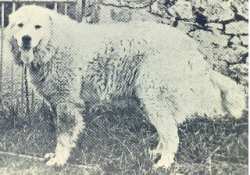

Historical Great Pyrenees |
||||
 |
||||
| Gazost
Premier, 1905 -chosen by Senac-Lagrange & other members of the Chenil Club
d'Argeles as representing perfection in type. Note that while the dog has good
bone, it is not extreme. His head is not refined, yet it has the correct wedge
shape with no apparent stop. He is an excellent, moderate, athletic-looking dog
with a strong back, good moderate angulation, correct almond-shaped eye and
lovely cupped feet. |

|
|||
 |
He has the correct height of hock (not a short hock -like
a shepherd dog), and a correct arroundera, which is to say that the tail makes
a loose wheel over the back -not the tight curl of the nordic breeds. No doubt,
Gazost would look more pleasing to our eyes if he had a good bath and brushing,
but it is important to remember the rustic origins of the breed. I feel it is
fair to say that this dog was, more than any other, the model for the standard
|
|||
| Patou de Betpouey, 1920's He displays the gorgeous head and eye which the Reunion des Amateurs de Chiens Pyreneens has always emphasized as essential for a true Pyrenean |
 |
|||
 |
Birouk II, 1920's - Another beautiful dog with a lovely head and wonderfully athletic build. | |||
| Patou, 1920's This dog has massive bone and yet retains a certain elegance. His head is coarse and may indicate a St. Bernard in his background. A few breeders crossed Pyrs with Saints after WWI, but the RACP rejected these crossbreds. Nevertheless, this dog did OK at shows, though even when he was the best dog there, he still usually only garnered a rating of Tres Bon (rather than the top rating, Excellent), no doubt because of his lack of head type. |
 |
|||
HOME | Pyrs | Pyr Sheps | About Us | Links